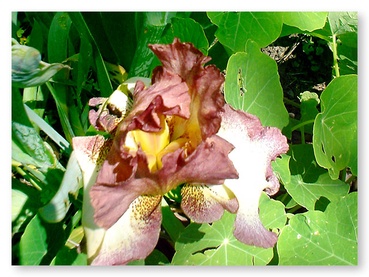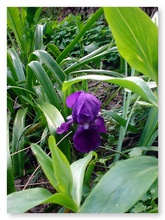 The Beardless Iris (Iris nelsonii) can be both red or yellow.
The Beardless Iris (Iris nelsonii) can be both red or yellow.  The Yellow Iris (Iris pseudacorus) is a native to Eurasia. It is classified as an invasive plant by the California Department of Food and Agriculture and by the California Invasive Plant Council.
The Yellow Iris (Iris pseudacorus) is a native to Eurasia. It is classified as an invasive plant by the California Department of Food and Agriculture and by the California Invasive Plant Council.  Iris giganticaerulea commonly known as the Louisiana Iris.
Iris giganticaerulea commonly known as the Louisiana Iris.  Aphylla Irises (Iris aphylla) are a beautiful dark purple and originate from Central Europe.
Aphylla Irises (Iris aphylla) are a beautiful dark purple and originate from Central Europe.
Irises (Iris spp.) are abundant in Davis, possibly because they're so darn easy to grow! Plant them and forget about them until you get so many irises that you need to divide the clump... about every other year. Despite what you might read on the planting directions when you purchase your iris bulbs, there's no need to dig up these rhizomes and refrigerate them each winter.
The large Iris family (Iridaceae) is comprised of perennial herbs from rhizomes, bulbs or corms, and includes crocuses, tigridias, gladioli and freesias; the family is further characterized by flowers having 3 sepals, 3 petals, and 3 stamens in line with the sepal. The Iris genus within this family is what most people think of when hearing the term iris — these are either bulbous or rhizomatous and can be identified by long, erect, flowering stems which may be flattened, and three to ten basal, sword-shaped leaves growing from dense clumps. Within this genus first identified by Linnaeus, there are now over three hundred species! The taxonomy of irises gets so obtuse that most gardeners simply prefer to separate the genus into bearded vs. unbearded irises.
Since irises are propagated by division, most gardeners will receive a rhizome with clipped roots and leaves — this can remain out of the ground for a week or two. Irises prefer sunny locations with well drained soil. Ideally, soil should be well turned with fertilizer to a depth of about ten inches. Despite all the special bulb tools and fertilizers that can be found in your local nursery, lazy gardeners can get away with just doing some basic soil preparation, sticking the rhizome/bulb in the ground so it's just below the soil surface, covering it up and giving it a good drink of water. The only real caution would be to amend heavy clay soil so your bulb or rhizome doesn't just rot in the ground.
If you have several plants, plant them about a foot apart facing the same direction so the rhizomes increase in the same direction, without crowding each other. In about two or three years, the new rhizomes will begin to crowd each other and you will want to divide the plant, cutting the newer parts of the rhizome free from the old, which can be tossed; division is best done a month or two after blooming.
There are no iris species native to Davis, but Longtube Iris (Iris macrosiphon) is native to the Yolo County foothills. Thirteen other iris species are native to other parts of California, and some can be grown successfully in Davis gardens.
One member of the Iris family (Iridaceae) is native to Davis: Blue-eyed Grass (Sisyrinchium bellum). This perennial herb grows up to two feet tall (but usually stays closer to one foot tall) and prefers full sun or partial shade. It often grows in grassy areas where there is a bit of moisture in winter and spring. After blooming, it dies back to the ground and is dormant over the summer, allowing it to survive dry summers. It can be propagated by seed or by division of its rhizomes, and the flower stems can be rooted. It self-sows.
Take a look at our Town Flora to find out what else grows in Davis!



